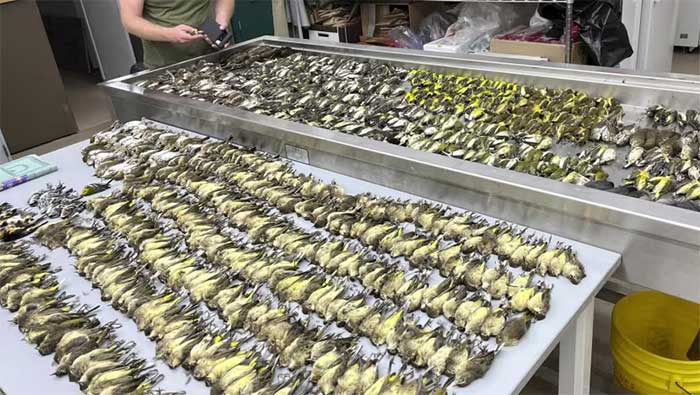Nearly 1,000 birds died overnight after colliding with the doors of the McCormick Place Lakeside Center, a result of a deadly combination of migration conditions, rain, low exhibition lighting, and glass walls.
As part of a migration research program, David Willard has been regularly checking the campus of the lakeside exhibition center in Chicago for dead birds for the past 40 years. On Thursday morning (October 5), he made a horrific discovery: Hundreds of dead birds piled up so thickly that they resembled a carpet.

In images provided by the Field Museum of Chicago, workers examine the bodies of migratory birds on October 5, 2023, that died after colliding with the doors of the McCormick Place Lakeside Center, an exhibition hall in Chicago, during the night of October 4-5, 2023. (Photo: AP).
Willard stated: “This is a shocking exception compared to what we have experienced. In 40 years of monitoring what happens at McCormick, we have never seen anything remotely close to that scale.“
Researchers estimate that hundreds of millions of birds die from window collisions in the U.S. each year. A study published in 2014 by scientists at the Smithsonian Conservation Biology Institute and the U.S. Fish and Wildlife Service found that this number ranges from 365 million to 988 million birds annually.
Window collision incidents are a problem occurring in most major cities across the U.S. Birds cannot see clear or reflective glass and do not recognize it as a deadly barrier.
Nocturnal migratory birds, such as sparrows and warblers, rely on stars for navigation. Bright lights from buildings both attract and confuse them, leading to collisions with windows or birds circling around lights until they die from exhaustion—a phenomenon known as fatal light attraction. For example, in 2017, nearly 400 birds were disoriented by the headlights of a skyscraper in Galveston, Texas, and died from colliding with windows.
Stan Temple, a retired professor of wildlife ecology and bird expert from the University of Wisconsin-Madison, noted that conditions were ripe for a significant migration wave of songbirds heading south through Chicago on Wednesday night.
These small songbirds forage during the day and migrate at night to avoid air disturbances and predators. Temple explained that they had been waiting for north winds to assist their journey south, but September saw unusually warm south winds that caused the birds to concentrate in the area.


















































